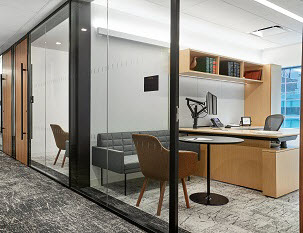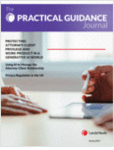 The future-facing redesign of Shearman & Sterling’s global New York headquarters is set to empower the firm’s personnel, meet the evolving needs of clients, and help revitalize the city
The future-facing redesign of Shearman & Sterling’s global New York headquarters is set to empower the firm’s personnel, meet the evolving needs of clients, and help revitalize the city
When Shearman & Sterling Executive Director and Chief Operating Officer Kenneth Johnsen first started at the nearly 150-year-old global firm in 1998, he found himself faced with an amalgamation of old-fashioned offices. Coming in a hierarchy of floor plans based on seniority, these offices did nothing to mitigate the competitive and politically charged atmosphere law firms are notorious for. The café, equipped with a few steel chairs and tables, reminded him more of a government service center than somewhere you would want to spend time with colleagues or clients. Layout and aesthetics aside, the infrastructure was also inefficient.
“As people came back to new glass-walled offices, open spaces, natural light and high ceilings after working remotely for so long, you can feel them feeding off the energy of the space,” says Johnsen. “However, despite all of these changes, our space continues to pay tribute to our firm’s long history, with a strong foot in the future.”
An extensive renovation, in partnership with London design and architecture firm Perkins&Will, began at the height of the COVID-19 pandemic in 2020. Today, Shearman & Sterling’s Manhattan office at 599 Lexington has a completely new look and feel. Although five floors have been shed, the space now boasts a double-level conference center that can also be set up for fine dining (as well as firm and client events), a bright café full of diverse art and cuisine, a tech bar, and a library.
“We wanted our clients to feel comfortable and at home in our office – whether they were dropping by for a meeting from a neighboring building or coming straight from the airport. Our clients can now store their belongings and freshen up as needed in designated areas after travel,” adds Johnsen.
Luckily for the team, COVID-19 changed very little about the blueprint for what has been internally dubbed “599 Reimagined”. The 340,000-square-foot space was already being built to anticipate the demands of the future workforce – and now includes an onsite nurse practitioner, showers, a yoga room, a wellness suite, and mothers’ rooms on every floor.
The human-centric model — which incorporates design balance, natural patterns, a customizable light and shade system to align with the body’s circadian rhythms, antibacterial surfaces, enhanced air filtration, air ionization technology, filtered water and sit-stand desks for all — is designed to make staff and clients feel both comfortable and cared for in the workplace. This compliments Shearman & Sterling’s popular hybrid working system that not only supports the evolving needs of clients and the firm’s growing talent base, but also enables elevated interactions between clients and employees.
“Supporting the return-to-work model and bringing the creature comforts of home into the workplace were both crucial to the project’s success. The new design has really resonated with our people, who spent two years at home creating meaningful environments for themselves,” says Arsha Cazazian-Clement, Director of Global Real Estate.
All offices are now the same size, whether you’re a seasoned partner or a business services professional.
“We all have to compete to keep and attract the best talent. Our new design is built for the future,” adds Cazazian-Clement.
The world also became much more concerned with sustainability during the pandemic. Reflecting upon Shearman & Sterling’s long-term sustainability projects, billable and pro bono work, the new workspace, anchored in eco-conscious design and construction practices, is on track for LEED-Gold certification. In addition to reducing the overall footprint of the 599 Lexington office space, the firm relinquished its space at 850 3rd Avenue, which used to be occupied by business services professionals. Today, all of Shearman & Sterling’s people sit in one building powered by low-voltage recycled Ethernet cables and equipped with occupancy sensors and lighting and shade systems that can be incrementally adjusted depending on the time of day and the weather – ensuring that only the necessary amount of power is used.
“We know sustainability is important to our people and society,” says Johnsen. “We wanted to reflect our firm’s many contributions to the community and environment.”
As a keystone member of the International WELL Building Institute and the first global law firm to participate in WELL Building Standard (WELL) at an enterprise scale, committing its 22 global offices to pursue the WELL rating, Shearman & Sterling has joined a global community that promises to provide better buildings, services and facilities for the physical and mental health of their employees. As a result, all building occupants have a sit-stand desk, and a low-power, high-tech control system that allows for personally curated illumination of each workspace. Sensors that monitor key variables — such as air quality, temperature and occupancy — and feed data back to the building’s “brain” allow the space to get smarter over time. And with the building’s state-of-the-art conference rooms, colleagues and clients working from home can still feel part of the culture as their images are projected onto giant 95-inch screens.
The firm also hopes the new and improved Manhattan office will allow them to connect with local causes and in turn act as a springboard for the revitalization of New York City, as disruption from the pandemic subsides. By encouraging associates to make a difference in their own communities, the firm believes these inviting and inclusive spaces will make a promising venue for transformative pro bono work.
“This building is a manifestation of our desire to support our clients, our people and the communities we live in,” says Johnsen.
Most importantly, the forward-facing features of this reimagined space –– whether aesthetic, technological or aspirational –– have come together to realize a workplace in which the firm’s people, regardless of their position, are keen to contribute.
“A lot of New Yorkers left during the pandemic and didn’t want to come back into an office environment,” says Cazazian-Clement. “But now I’m hearing from across the board that they love coming here. That’s big for New York, and New York needs it.”




